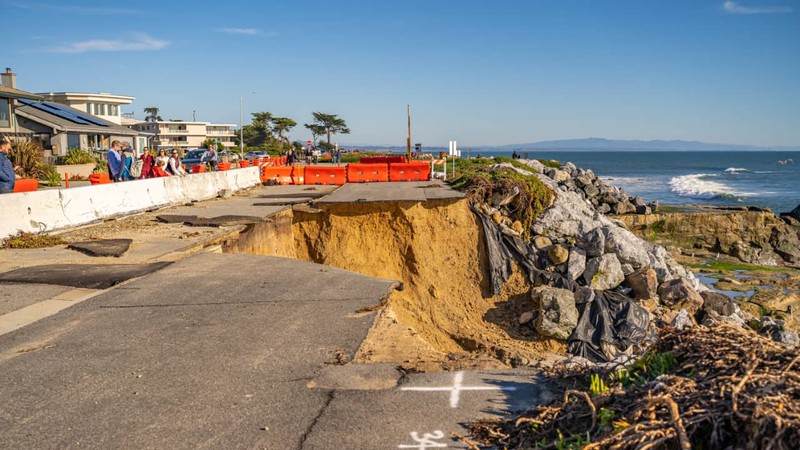As communities in California face accelerating rounds of fire, flood and drought, the civic fabric adapts.

West Cliff Drive in Santa Cruz, California, following a storm in January 2023. Throughout the state, communities are being forced to budget for disaster. Iv-olga Shutterstock/standard
At a recent meeting, Santa Cruz County staff reported the budget outlook for the coming year as "bleak." County Supervisors are grappling with $140 million in damages to county roads caused by the winter storms of 2023, a staggering amount for a single year in a county with an annual total budget of $1.1B.
In neighboring Monterey County, residents of the community of Pajaro, evacuated during flooding in the same storms when river levees were breached, have yet to return home. At the other end of the county, the California Department of Transportation (CalTrans) is contending with yet another failure along a stretch of Highway 1, adding to the efforts already underway to repair landslides in three other locations severing the main connection to the community of Big Sur.
What We're Seeing
The civic fabric of California is adapting to the accelerating cycle of extreme weather and fire events through the allocation of increasing resources responding to events as they happen and preparing for events and conditions to come.
This isn't confined to government budgets. It's also impacting the nonprofit sector, as Community Foundations and other nonprofit community groups step up to the challenge of providing services to growing numbers of affected and displaced members of their communities. In North Lake Tahoe, the Tahoe Truckee Community Foundation is funding a COAD (Community Organizations Active in Disaster) to coordinate planning and providing emergency services in the face of wildfires and increasingly massive winter storms, such as the region faced in March.
Nor is the climate-crisis induced emergency confined to organizations or institutions. Individual homeowners bear higher costs as insurers exit the market and displaced families compete for shelter in a state already beset by housing shortages.
All while Californians are already impacted by homelessness, the opioid/drug epidemic, and the lingering, continuing costs of endemic COVID.
What We're Doing
At California Local, we often talk about our mission to document the civic fabric of communities in California, where "civic fabric" is the combined energy of the individuals, businesses, nonprofits and government agencies active in the community.
One of the things baked into our system is a basic taxonomy to localize and categorize the spaces, actors and actions which define the civic fabric. This includes a database of information and institutions organized into topics, from Agriculture and Animals to Veterans and Water.
“Resilience” is one of a couple dozen such categories, because communities focus a lot of resources on the preparation and response to periodic disruptive events such as earthquakes, wildfires and flooding, in addition to the slow-rolling daily grinds of homelessness, opioid addiction and mental health.
In light of the rapid onset of climate-related impacts, we’re directing more of our ongoing journalism to covering the community response to climate events and helping you be an active participant in community efforts to adapt to our changing world.
Join the First Responders
In a climate crisis, we all must be better prepared for the power to go out for three days or the road to wash out, or a fire or flood or earthquake to hit. It’s just as important to paticipate in the collective response.
• Consider training for and joining a Community Emergency Response Team (CERT).
• Consider volunteering or donating to your local Community Foundation or other service organization contributing to local resilience and relief.
• Inform yourself as to how your local government is allocating budget and other resources. As communities adapt, painful choices will arise and as a citizen, you have a voice in that process.
• Join California Local, or sign up for our newsletter, to stay informed and connected.